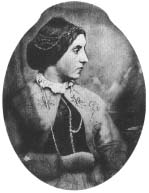Jane C Webb Loudon 1807 – 1858
May 06, 2009
 Jane C Webb
Loudon 1807 – 1858 was
an early pioneer of science fiction.
Jane C Webb
Loudon 1807 – 1858 was
an early pioneer of science fiction.
Jane Loudon was at the centre of an intelligentsia which included Hans Christian Andersen, Charlotte Bronte, Catharine Crowe, Charles Darwin, Charles Dickens, the Drysdale family, Harriet Martineau, William Makepeace Thackeray, and many others.
As she later wrote, after her father’s death she found “on the winding up of his affairs that it would be necessary to do something for my support. I had written a strange, wild novel, called The Mummy, in which I had laid the scene in the twenty second century, and attempted to predict the state of improvement to which this country might possibly arrive.”
The possible sources of inspiration include the general fashion for anything Pharaonic inspired by the French researches during the Napoleonic invasion of Egypt; the 1821 public unwrappings of Egyptian mummies in a theatre near Piccadilly which she may have attended as a girl; and, very likely, the 1818 novel by Mary Shelley, Frankenstein.
As Mary Shelley had written of Frankenstein’s creation, “A mummy again endued with animation could not be so hideous as that wretch,” which may have triggered young Miss Webb’s later concept. In any case, at many points she deals in greater clarity with elements from the earlier book: the loathing for the much desired object, the immediate arrest for crime and attempt to lie one’s way out of it.
However, unlike the Frankenstein monster, the hideous revived Cheops is not shuffling around dealing out horror and death, but giving canny advice on politics and life to those who befriend him. In fact, in some ways The Mummy may be seen as her reaction to themes in Frankenstein: her mummy specifically says he is allowed life only by divine favor, rather than being indisputably vivified only by mortal science…
Unlike many early science fiction works (Mary Shelley’s The Last Man, the anonymous 18th century The Reign of King George VI), Loudon did not portray the future as her own day with only political changes: besides those, she filled her world with foreseeable changes in technology, society, and even fashion.
Her court ladies wear trousers and hair ornaments of controlled flame. Surgeons and lawyers may be steam powered automatons. There is even a kind of Internet predicted in it. Besides attempting to account for the revivification of The Mummy in scientific terms - galvanic shock rather than incantations - “she embodied ideas of scientific progress and discovery, that now read like prophecies” to those later down the 1800s. Her social attitudes rank this book among feminist novels.
The Mummy was published anonymously in 1827 by Henry Colburn in three volumes, as was usual in that day so that each small volume could be easily carried around. It drew many favorable reviews, including one in 1829 in The Gardener’s Magazine on the inventions proposed in it.
“Among other foreshadowings of things that were to be, was a steam plough, and this attracted the attention of John Claudius Loudon, whose numerous and valuable works on gardening, agriculture, etc., are so well known, led to an acquaintance, which terminated in a matrimonial connection.”
In February, John Claudius Loudon mentioned to a female friend of his that he would like to meet the author of The Mummy, a woman who happened to know Jane. and arranged an introduction. As Jane later wrote, “It may easily be supposed that he was surprised to find the author of the book a woman; but I believe that from that evening he formed an attachment to me, and, in fact, we were married on the 14th of the following September.”
In 1829, she published the semi fictional Stories of a Bride, her second and last foray in fiction.
She became fascinated with her husband’s field of agriculture and gardening. She found the gardening manuals of the day confusing as they were written for those already deeply into the field via some apprenticeship: there were no entry level manuals.
She wisely saw the need for and potential interest in such books, and set to writing them when she herself learned: Instructions in Gardening for Ladies; The Ladies’ Flower Garden; The Ladies’ Companion to the Flower Garden; Botany for Ladies; The Lady’s Magazine of Gardening, etc. According to Adams, these became “standard books of reference, and attained a large circulation.” She was not only influenced by her husband in gardening, but by John Lindley, whose lectures she attended and ardently seconded his concepts of gardening as an occupation very fit for ladies.
She learned to plant and tend in the meticulous manner her husband needed for his researches and was his helper if not co-author on his books hereafter.
In 1832, they had a daughter, Agnes Loudon, who would grow up to author children’s books.
The Loudons were considered the leading horticulturalists of their day, and their circle of friends included Charles Dickens and William Makepeace Thackeray.
In 1843, the long ill Mr. Loudon died of lung cancer, leaving Jane in much the same situation as before her marriage, but with a 10 year-old daughter to raise. Again, she turned to her pen for a living. She was helped by “a pension of a hundred pounds per annum, from the Civil List, which she has deservedly gained.”
By 1848, Agnes was 16, beautiful, and extravagant. Jane tried to make ends meet more closely for two years by working as the editor of The Ladies Companion at Home and Abroad. Exhausted, she lived without further publishing until 1858.